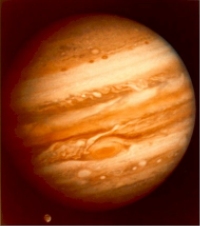
Jupiter is the largest planet (about 1300 times the volume of the Earth), -and the first of the "Jovian" or giant gas planets (Jupiter, Saturn, Uranus and Neptune). These "gas giants" are much bigger and more massive than the terrestrial planets (Mercury, Venus, Earth and Mars), but they are less dense. Jupiter's density is only 1.3 times that of water. Although it is made of light substances, Jupiter in so big that it has three and a half times the mass of all the other planets put together.
Most of our detailed knowledge of Jupiter was gained by the space probes Pioneer 10 and Pioneer 11 in 1973-74, and Voyager 1 and Voyager 2 in 1979. Jupiter is made up mainly of hydrogen and helium gas; chemically it is more like the Sun and the stars than like the Earth. There is no solid surface crust. The gas just gets thicker with depth until, deep down, a liquid phase is reached: the liquid molecular hydrogen layer. Much deeper again, under enormous pressure, is the ultra-compressed liquid "metallic hydrogen" interior. At the centre is a rocky core of iron and silicates equal in mass to about 20 Earths. Jupiter's total mass is about 318 Earths.
Apart from the distinctive cloud bands across the face of the planet, the most prominent feature on Jupiter in the Great Red Spot. It measures about 14 OOO x 30 000 km; two Earths would easily fit into it. The Great Red Spot has been observed ever since telescopes were invented, nearly 400 years ago. It is believed to be a huge anticyclone, a high-pressure storm, raging in the Jovian atmosphere. When Voyager 1 flew by Jupiter in 1979, it searched for rings similar to those around Saturn. A thin, dark ring of material around the planet was discovered, and this was soon confirmed by Voyager 2.
Like the other giant planets, Jupiter has many moons - 16 in all. Spacecraft could land on most of these moons as they are solid, made up of rock and ice. Jupiter's four biggest moons (the "Galilean Satellites") can be seen with a small telescope: they are - Io, Europa, Ganymade, and Callisto. Ganymede is the biggest moon in the whole solar system, bigger than either Mercury or Pluto. Io, the third largest moon, is one of only three bodies in the Solar System known to have volcanic activity (the other two are Earth and Triton).
Physical Data
Jupiter's diameter:
142,984 km
Distance from Earth: 628.7 million km
Distance from Sun: 778.3 million km
Equatorial period of rotation: 9hr 55min
Period of orbit: 11.86 years
Number of moons: 16 (+ a ring)